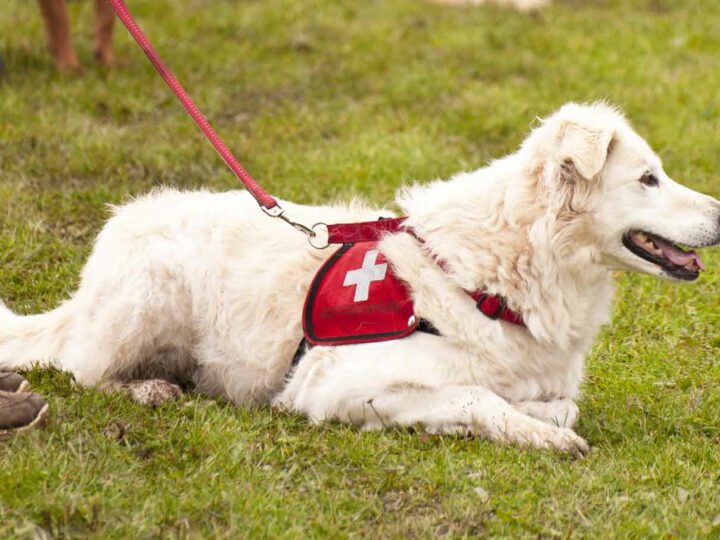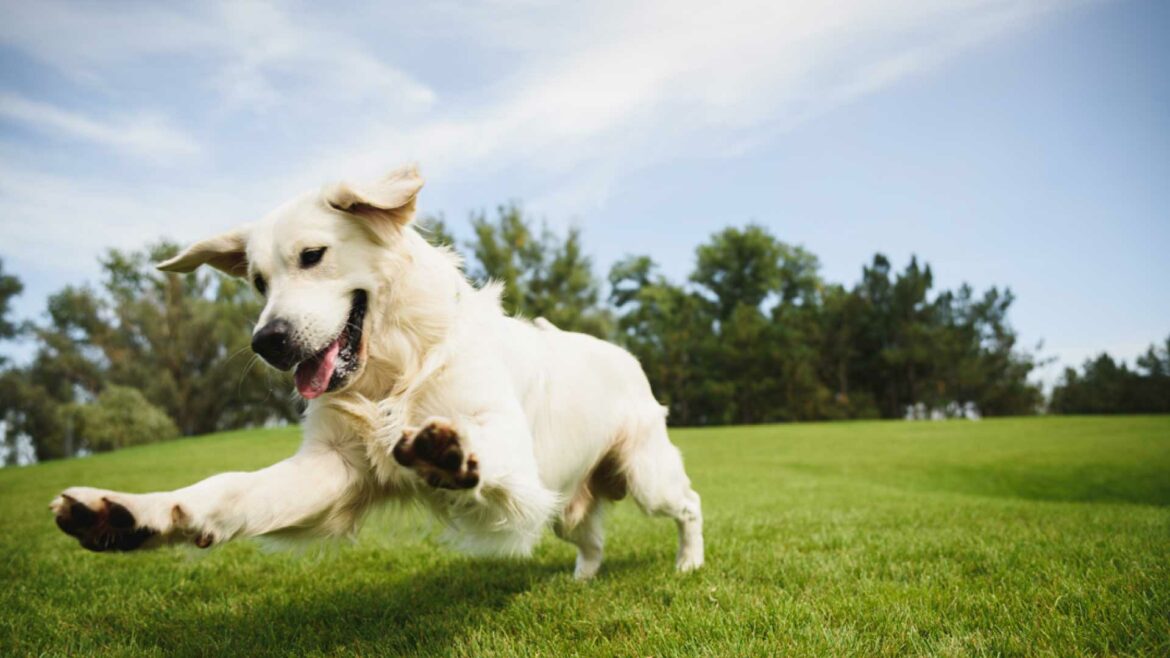
On June 5th, we celebrate World Environment Day, a moment to reflect on the relationship between living beings and nature and to promote respectful behavior toward our planet. In this context, it’s crucial to examine how pets, particularly dogs, interact with their surroundings. Dogs, loyal companions of many people, have a significant impact on the environments they frequent, influencing and being influenced in return.
In this article, we will explore how the environment affects dogs’ behavior and how, in turn, dogs can influence the same environment. We’ll discuss topics like the importance of picking up after your dog, the reasons behind grass-eating behavior, and how dogs can contribute to changes in the environments they interact with.
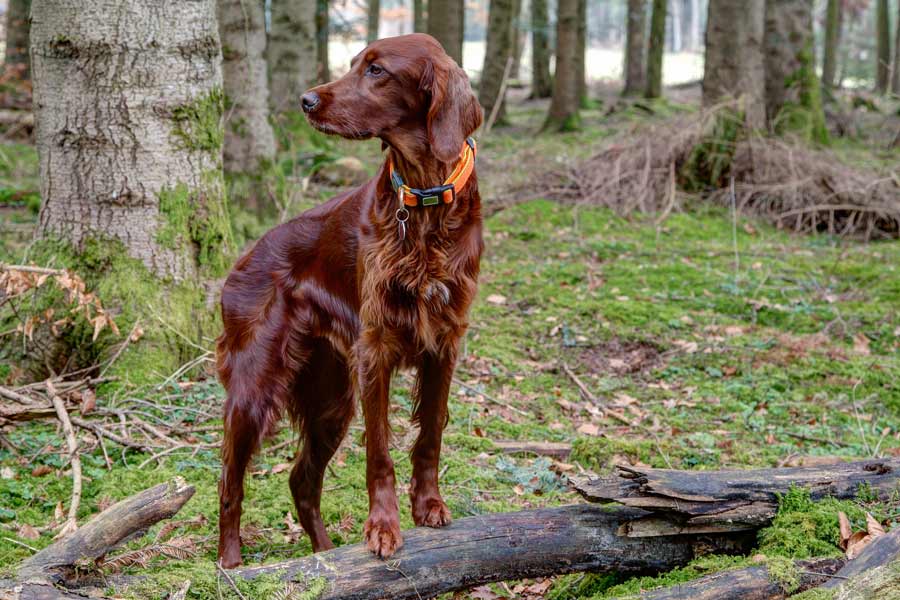
Knowing how dogs and their environment influence each other helps us foster a better relationship with the places we live in.
The interaction between dogs and their environment
The environment as a source of stimuli
For dogs, the environment is much more than just a physical space; it is a setting rich in sensory stimuli that deeply influence their behavior and well-being. Every park walk, mountain hike, or stroll around the block offers dogs a wide range of stimuli engaging their senses of smell, hearing, and sight. This plays an essential role both behaviorally and physiologically, as it activates cognitive processes to keep dogs mentally sharp and physically fit.
Scents are particularly important for dogs, as they have an extraordinarily developed sense of smell. Did you know that a dog’s nose can house up to 300 million olfactory receptors, far more than humans? A dog’s brain is highly specialized for processing and selecting smells in their environment, much like the human brain excels in verbal learning. For our furry friends, every environment offers a wealth of information through scents, which can influence their behavior in various ways, from curiosity to fear, excitement to calmness.
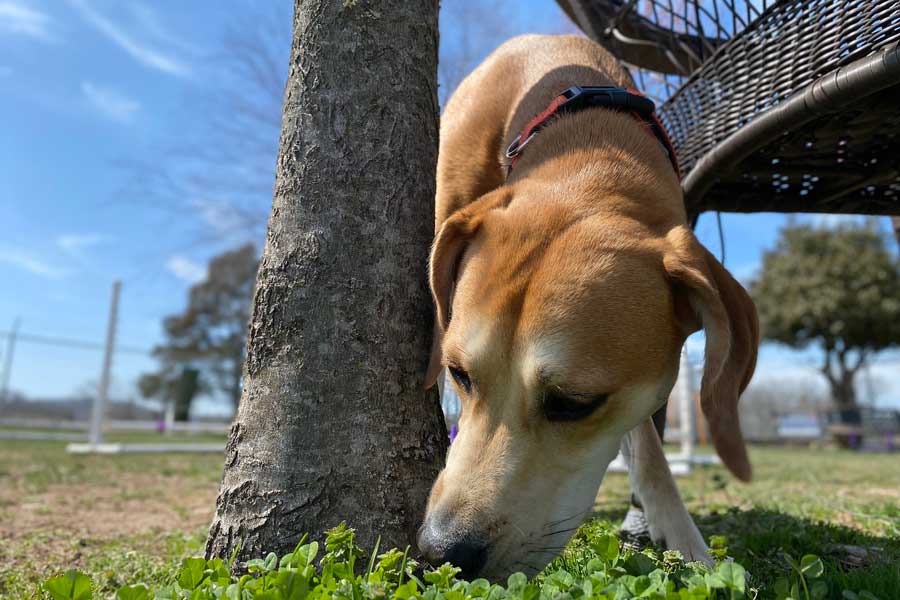
What might seem like just a tree to us is an entire world of discovery for our dog.
A stimulating and varied environment contributes not only to a dog’s physical health but also to his mental well-being. Boredom and lack of stimuli can lead to behaviors like chewing inappropriate objects, excessive barking, or digging holes in the garden, actions often linked to stress. Thus, it’s essential to provide dogs with a rich, diverse, and safe environment, allowing them to explore and satisfy their physiological needs.
Urban environments, for example, can pose unique challenges for dogs. Cities are full of stimuli but can also be sources of tension due to traffic, loud noises, and the large number of people encountered daily. These are overwhelming situations for our furry friends to manage. To help them adapt, it’s essential to gradually expose puppies to such environments, helping them develop the skills needed to navigate these scenarios confidently. Additionally, urban dog keepers should seek to provide quality experiences, like park walks and interactive games, to prevent signs of stress from developing over time.
For dogs, sniffing and exploring their surroundings is crucial. It allows them to gather and share essential information through marking, understand their environment, and orient themselves—it’s like creating their personal map! 🤭
Why do dogs mark their territory?
Marking territory is how dogs set the coordinates of their domain, contributing to the creation of this virtual map, helping them recognize stops, paths, and boundaries they’ve established. But it’s not just that; when dogs mark their territory, they are also communicating, conveying emotions experienced at that moment and leaving information for other dogs that might pass by. Some studies even suggest that these markings can reveal how long ago another individual passed through the same spot.
Conversely, as dogs sniff around during a walk, they are also receiving information from the environment and other dogs who have been there. They’re learning about the world through their sense of smell, just as we use our vision to navigate daily life.
Should I pick up my dog’s waste?
One of the fundamental responsibilities of dog owners is to pick up their pet’s waste. This simple act has a significant impact on the environment and the well-being of other animals and people. Dog waste can contain harmful bacteria and parasites, such as E. Coli, Giardia, and Salmonella, which can contaminate soil and water, posing risks to both other pets and humans.
We recently wrote an article about common dog illnesses, their transmission, and prevention.
Additionally, dog waste doesn’t decompose as quickly as you might think. In natural environments like parks or alpine areas, decomposition can take months, during which bacteria and parasites can spread. Particularly in mountainous regions, it’s crucial to pick up dog waste to avoid contaminating local flora and fauna. Mountain ecosystems are often fragile and unaccustomed to the bacteria present in dog waste, which can disrupt the natural balance and harm native species.
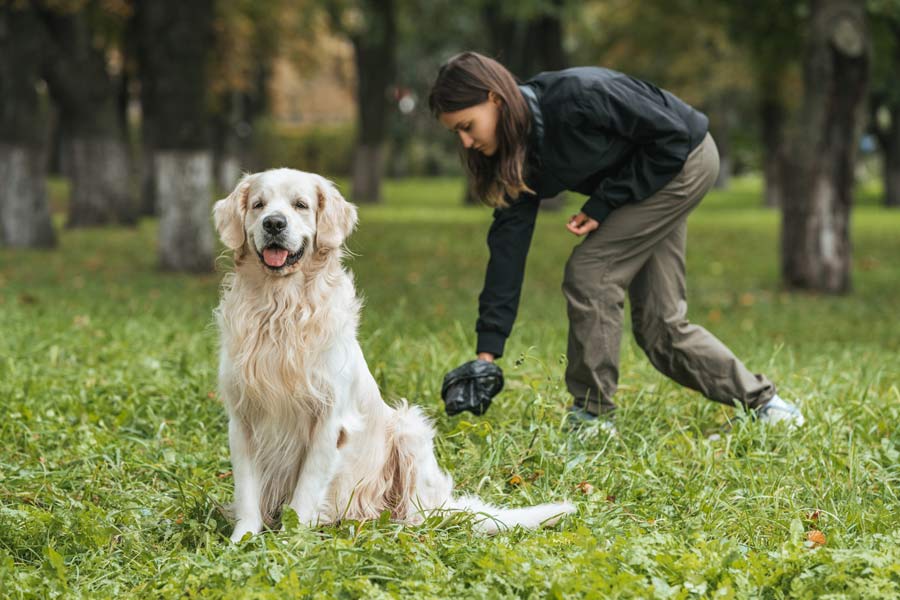
Picking up your dog’s waste should be a standard habit.
Cleaning up after your dog isn’t just about cleanliness; it’s also about protecting the environment. Dog waste can contribute to the eutrophication of surface waters, a process that leads to excessive growth of algae and aquatic plants, reducing oxygen levels for other organisms and harming local biodiversity. In urban areas, uncollected dog waste can end up in drainage systems, polluting local water sources and negatively impacting water quality and aquatic life.
Why does my dog eat grass?
One of the most curious behaviors observed in dogs is grass-eating. This peculiar habit is very common among our furry friends, so much so that it has sparked many hypotheses among experts. Some believe that dogs eat grass to improve digestion or to alleviate gastrointestinal discomfort. Grass can act as a natural emetic, inducing vomiting and helping the dog expel unwanted substances from his stomach.
Other experts suggest that grass might provide essential nutrients or help expel intestinal parasites. Some theories propose that eating grass is a behavior inherited from their wild ancestors, wolves, who consumed vegetation to supplement their meat-based diet. Did you know that dogs can even follow a vegan diet?
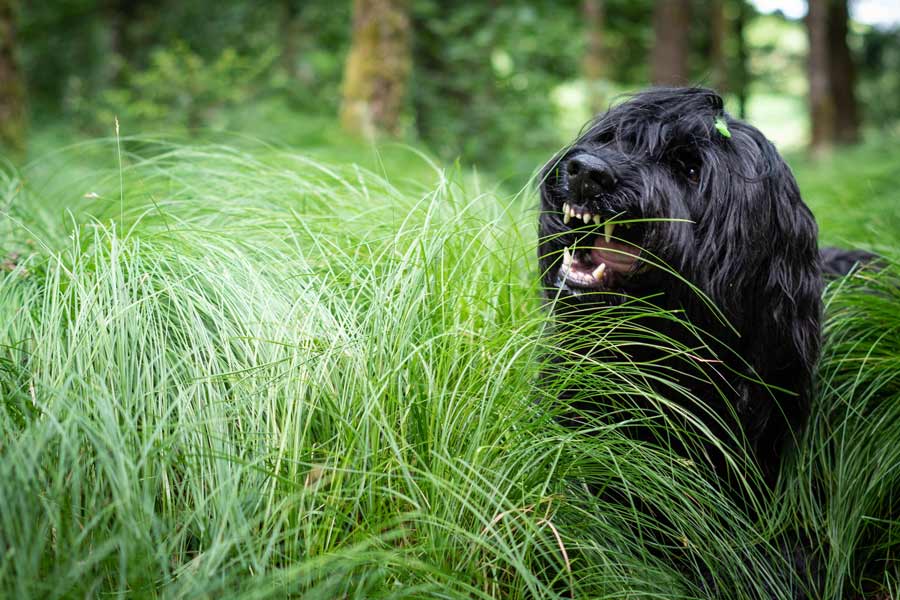
Eating grass is an entirely normal behavior for our furry friends.
It’s important to note that eating grass is generally considered a natural behavior for dogs and is not a cause for concern unless accompanied by signs of illness or excessive consumption. However, we should ensure that the grass in question does not show signs of pesticides or other harmful chemicals that could affect the dog’s health.
Additionally, the act of eating grass might also be a behavior dogs exhibit to cope with stressful situations. If we have any doubts about this, we can always consult qualified professionals such as trainers, canine educators, or veterinarians specialized in canine behavior.
How can my dog impact the environment?
Soil erosion and vegetation damage
Dogs can contribute to soil erosion and vegetation damage, particularly in natural areas and public parks. For instance, repeated trampling by dogs can compact the soil, reducing its ability to retain water and support plant growth. This can lead to the death of local plants and soil erosion, causing the loss of habitats for other species. Naturally, these conditions are not common or quick to occur, but they are considerations worth keeping in mind.
Another behavior to monitor is digging, an action that can damage plant roots, compromise their health, and further contribute to soil erosion. In fragile environments such as coastal dunes or grasslands, the damage can be particularly significant, with long-term effects on local biodiversity.
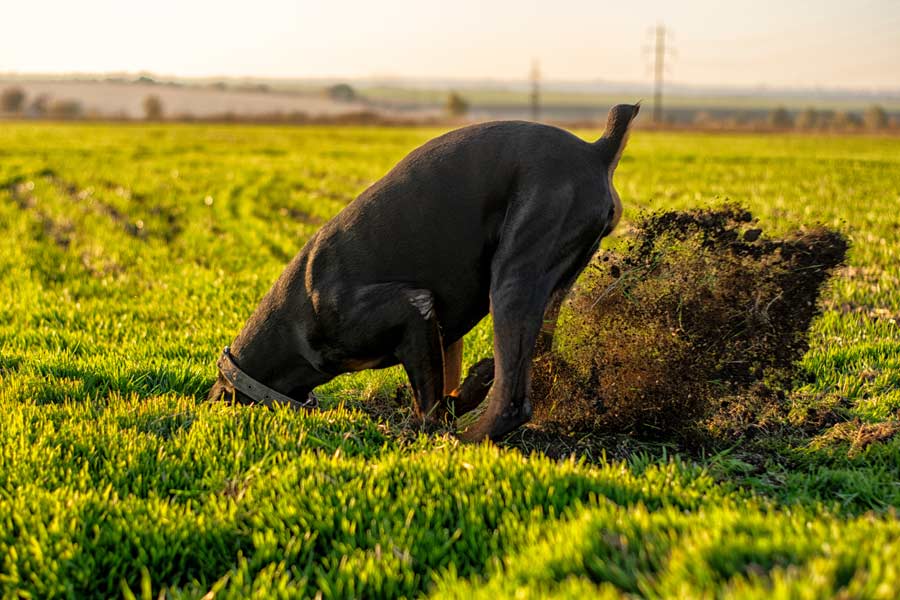
Some dogs love to dig holes, sometimes a bit too much…
Disturbing wildlife
Sometimes a mountain walk with our furry friend can unintentionally disturb wildlife. The presence of a dog in a natural area can scare wild animals, disrupting their normal activities such as feeding, resting, and mating. This disturbance can negatively affect the health and reproductive success of wildlife.
Dogs might also prey on small mammals, birds, reptiles, and amphibians, altering local predatory dynamics. Even though most domestic dogs don’t actively hunt, their predatory instincts can lead to the unintended capture of wildlife.
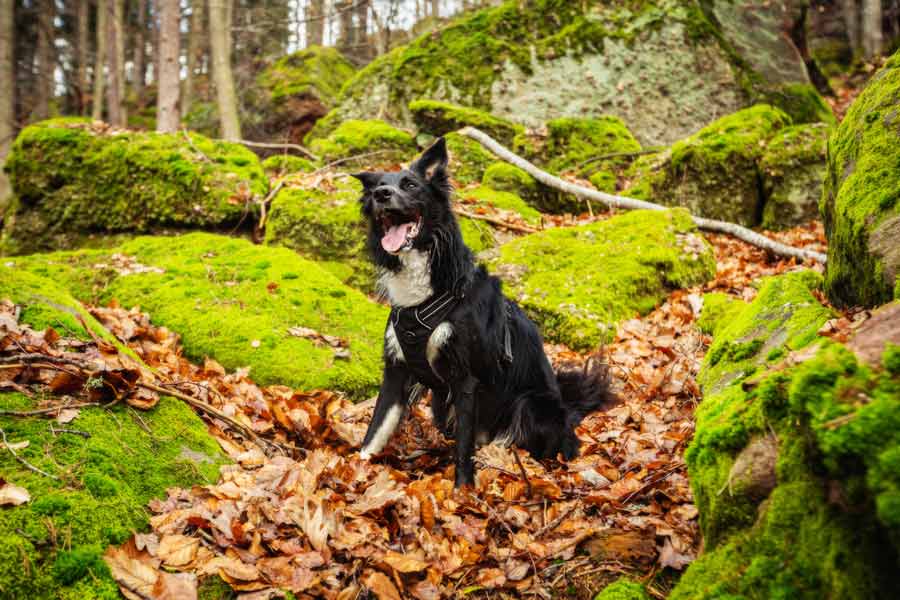
When in nature with our dogs, let’s remember to avoid disturbing local wildlife.
Transporting invasive species on their fur
Dogs can unintentionally contribute to the spread of invasive species by carrying seeds, spores, and small organisms in their fur or on their paws. While using animals’ coats for seed dispersion has always been a “technique” used by plants, bringing our dogs into areas with delicate biodiversity could introduce invasive species that compete with native ones, altering local ecosystems.
In particular, invasive plants can quickly establish themselves in new environments, leading to changes in vegetation composition and consequently compromising natural habitats.
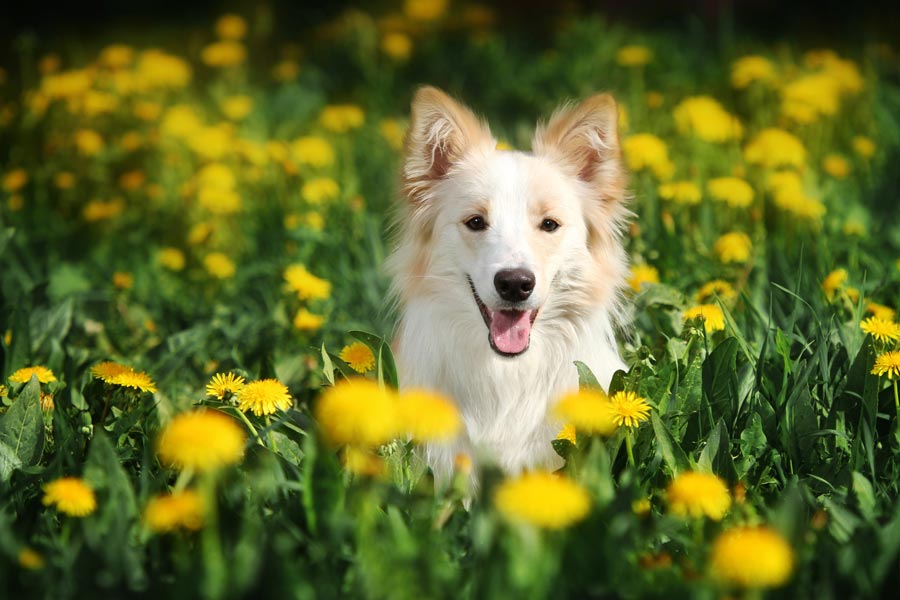
A quick pass through a field, and our dog becomes the perfect carrier for floral pollen.
The interactions between dogs and their environments highlight the importance of responsible behavior from pet owners. Picking up dog waste, understanding natural behaviors like grass-eating, and being mindful of their environmental impact are all crucial steps to protecting nature and ensuring harmonious coexistence between all forms of life.
Indeed, a responsible and conscious approach to interactions between living beings and nature allows us to fully enjoy every moment and place in the environment we share, always accompanied by our furry life companions!
And remember, respecting the environment is respecting yourself.
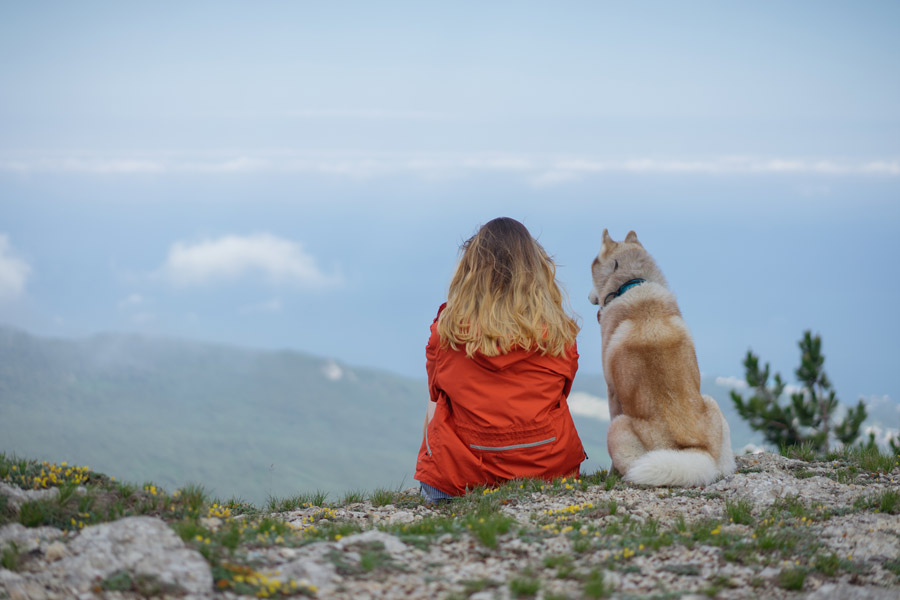
Your dog, you and an environment ready to be discovered and lived in perfect harmony.
Article written in collaboration with Chiara Festelli, Canine Educator.





